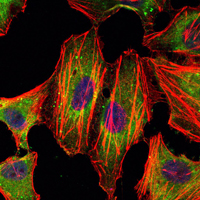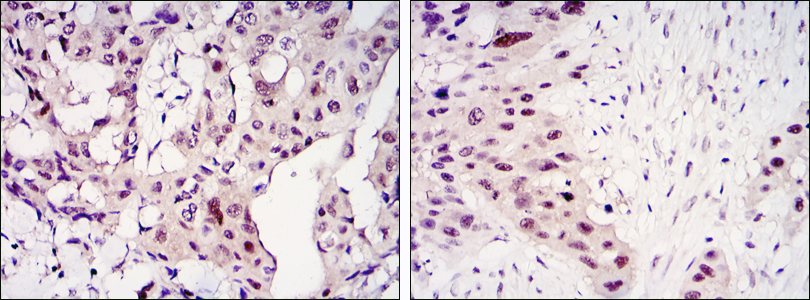-
Product Name
Anti-STAT3 (5G6) Mouse antibody
- Documents
-
Description
STAT3 (5G6) Mouse monoclonal antibody
-
Tested applications
WB, IHC-P, ICC/IF
-
Species reactivity
Human, Mouse, Monkey
-
Isotype
Mouse IgG1
-
Preparation
Antigen: Purified recombinant fragment of human STAT3 expressed in E. Coli.
-
Clonality
Monoclonal
-
Formulation
Ascitic fluid containing 0.03% sodium azide.
-
Storage instructions
Store at 4°C short term. Store at -20°C long term. Avoid freeze / thaw cycle.
-
Applications
WB: 1/500 - 1/2000
IHC: 1/200 - 1/1000
ICC: 1/200 - 1/1000
ELISA: 1/10000
-
Validations

Immunofluorescence analysis of Hela cells using STAT3 mouse mAb (green). Blue

Western blot detection of Stat3 in Hela cell lysates using Stat3 mouse mAb (1:1000 diluted).Predicted band size:88KDa.Observed band size:88KDa.

Immunohistochemical analysis of paraffin-embedded mammary cancer tissues (left) and lung cancer tissues (right) using STAT3 mouse mAb with DAB staining.
-
Background
Swiss-Prot Acc.P40763.The Stat3 transcription factor is an important signaling molecule for many cytokines and growth-factor receptors and is required for murine fetal development . Stat3 is constitutively activated in a number of human tumors and possesses oncogenic potential and anti-apoptotic activities. Stat3 is activated by phosphorylation at Tyr705, which induces dimerization, nuclear translocation and DNA binding. Transcriptional activation seems to be regulated by phosphorylation at Ser727 through the MAPK or mTOR pathways. Stat3 isoform expression appears to reflect biological function as the relative expression levels of Stat3α (86 kDa) and Stat3β (79 kDa) depend on cell type, ligand exposure or cell maturation stage. It is notable that Stat3β lacks the serine phosphorylation site within the carboxy-terminal transcriptional activation domain.Tissue specificity: Heart, brain, placenta, lung, liver, skeletal muscle, kidney and pancreas.
Related Products / Services
Please note: All products are "FOR RESEARCH USE ONLY AND ARE NOT INTENDED FOR DIAGNOSTIC OR THERAPEUTIC USE"
